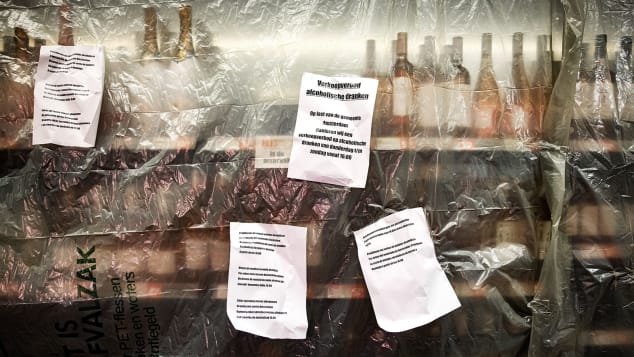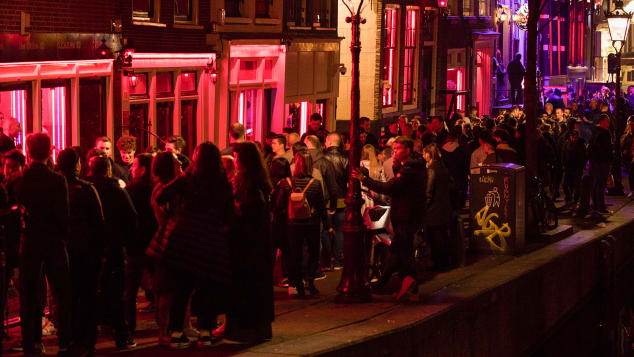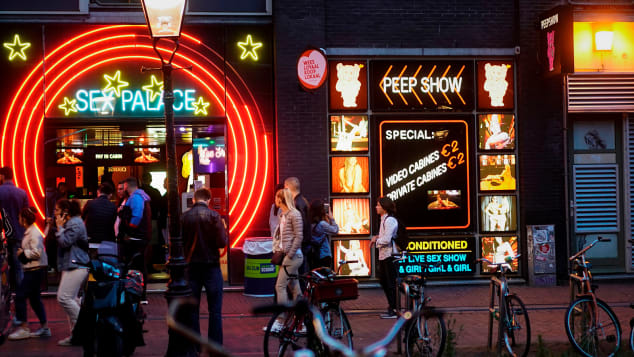Overrun Amsterdam’s “Stay Away” Campaign Targets Sex and Drug Visitors

On a chilly Saturday in the first week of December, the sun has barely set. But things are already heating up in Amsterdam's Red Light District.
During World Cup soccer matches, loud cheers can be heard from crowded bars. From coffee establishments, marijuana odors can be detected. Numerous tourists crowd the congested streets, making it challenging or even impossible for a car or even a bike to pass through.
A few males pause to inquire about the services offered by lingerie-clad sex workers posing behind brothel windows. However, the vast majority of people just gawk or gaze as they walk.
In defiance of signs prohibiting photography, a middle-aged man in jeans and a baseball cap takes a picture of his friend against the glass of one business along the Oudezijds Voorburgwal canal. For a second photo, they switch places, and after laughing, they leave.
In one of the most notorious tourist destinations in the world, it's just another day. The De Wallen area, as it is known locally, will eventually entice tourists who come to appreciate its distinctive heritage, architecture, and culture rather than its vices, if city officials have their way.
City officials recently unveiled policy recommendations "to control tourism growth and disturbance" and battle overcrowding as part of an ongoing effort to improve Amsterdam's reputation, lessen disruptive conduct from visitors, and increase livability and safety for inhabitants.
Initiatives to curb unruly visitor behavior are included in the most recent round of proposed regulations, including reducing the number of river excursions, adopting early closing times for pubs, clubs, and window brothels, and outlawing cannabis smoking in specific urban areas.
Another component of the project, known as the "stay away" campaign, is to "actively discourage overseas visitors with aspirations to 'go wild' in Amsterdam."
Deputy Mayor Sofyan Mbarki said in a statement that "some businesses exploit Amsterdam's image to pitch it as a place of 'infinite possibilities'". "Some groups of tourists believe it to be a city where everything is possible as a result. The Municipal Executive does not find this type of tourism or products that target these populations desirable."
The November 30th-announced policy ideas, which are a part of a larger effort to address mass tourism, must be approved by city council on December 21 in order to become effective. Some, though, are already on board in the Amsterdam tourism industry.
The general manager of the Mövenpick Hotel Amsterdam City Center, Remco Groenhuijzen, argues that "we need get away of the image of sex, drugs, and rock and roll." "Having a city on the brink isn't necessarily a bad thing. But that doesn't give you a free license to behave badly when you come here."
The appropriate balance
 |
| An alcohol sales ban was introduced in Amsterdam's Red Light District earlier this year. Hollandse Hoogte/Shutterstock |
According to Groenhuijzen, the majority of the 24 four- and five-star hotels that make up the Luxury Hotels of Amsterdam, an association of which he is chairman, support the city's efforts to improve its reputation by taking a variety of steps to address (and prevent) the undesirable effects of unruly tourists.
According to Groenhuijzen, "as hoteliers, we believe that a city should be livable since that's when it's great to come here." "To have the proper balance was always Amsterdam's strength."
But overtourism has drastically thrown that equilibrium out of gear recently, especially in heavily traveled areas like De Wallen, especially as post-pandemic tourism has returned in a big way.
More than 18 million overnight tourists are expected in Amsterdam in 2023, which is roughly 22 times the city's estimated 822,000 resident population. There may be an additional 24 to 25 million day visitors by 2025, bringing the total to 23 million. According to a 2021 ordinance titled "Amsterdam Tourism in Balance," the city council will be "obligated to interfere" when the number of overnight visitors hits 18 million.
Director Geerte Udo of Amsterdam & Partners, the city's public-private marketing charity, says that between 10 and 15 percent of Amsterdam's tourism economy is concentrated in the Red Light District. Udo notes that certain areas are particularly troublesome, but when the obnoxious tourists are combined with the overcrowding issues, on weekends "it's really, very unlivable in the old city center on these days."
Udo described the city's tourism revamp as a multi-layered strategy with targeted campaigns that cater to particular visitor demographics, repositioning Amsterdam as a destination that offers attractions beyond brothels and cannabis cafes, and making the city safer and more livable for locals as well as more alluring for tourists.
One particular policy, for instance, would target day tourists, many of whom arrive by automobile from all over the Netherlands as well as from nearby nations like Germany and opt to spend the night in their cars rather than hotels.
Udo frequently avoids using the phrase "Red Light District" while speaking about the ideas. She notes that the name has evolved into something like to a theme park for a community. And if we want to alter public image, we shouldn't continually bringing up the Red Light District if we would rather see the red lights turn off.
Erotic Center is still suspended
 |
| Tourists throng the neighborhood in this photo taken pre-pandemic in March 2019. Peter Dejong/AP |
Those infamous lights are still on right now. However, they may decline in the upcoming year depending on the outcome of a proposed "erotic center" that would consolidate the window brothels into a single structure outside of town. This is possibly the most contentious component of the city's tourism revival.
Femke Halsema, the first female mayor of the Dutch metropolis of Amsterdam, had originally envisioned the project as an "erotic hotel."
Some groups, including some political parties, have endorsed it while others, most notably sex workers, have harshly denounced it.
They contend that eliminating the windows' visibility makes their work less safe and that moving the center to a less-traveled region of the city will hurt their bottom line.
The erotic center "will fail and become a financial catastrophe," according to Jeroen de Jong, chief operating officer of Amsterdam Red Light District Tours, whose app provides self-guided excursions through the neighborhood (in-person tours were outlawed at the start of 2020).
De Jong also mentioned that there are a few additional locations with window brothels close to Amsterdam. He stated through email that "sex workers currently have the option to work in multiple venues in the city."
The opening date of the multi-story, 15,000 square foot center, which has a hired architect on board, is unknown. The city has delayed making a choice and may add more locations to the list after significant opposition to the first eight proposed sites, according to the Dutch newspaper Het Parool.
Halsema, though, doesn't waver in her resolve. This fall, she told the news source DutchNews.NL, "I hope it's possible to build an erotic center that has some class and distinction and isn't a location where only minor criminals, the most vulnerable women assemble, but also those who are not ashamed to go there."
"Leave it alone"
 |
| Dutch brothels reopened post-Covid in July 2020. Kenzo Tribouillard/AFP/Getty Images |
The Red Light District's future may be uncertain, but for the time being, everything are going according to plan. That's as it should be, according to many of the employees and customers who frequent the neighborhood's adult novelty shops, cannabis cafes, pornographic shows, and other businesses.
In between serving a steady stream of clients, Linda Nap, an employee of a sex accessory store in De Wallen, says, "[Government] just wants to regress everything, move it away, bring all these gorgeous houses back to rich people."
According to de Jong, the city would be considerably better served by boosting its police presence in the Red Light District, which is something that locals and business owners in the area frequently ask for instead of wasting money on anti-tourism initiatives. He claims that one common concern is, "We don't want more rules, but more enforcers and police."
According to Nap, who claims that many of her clients are sex workers, the city's ongoing initiatives would rob the area of its distinct character, which, like the industry it has centered itself around, has been thriving for decades. She also asserts that despite residents' complaints with congestion and loudness, the realities of neighborhood life have always been very obvious.
People don't just come to this city for the canals and tulips, adds Nap, "[The sex industry] has been around here since the 1600s." "Ignore it. If there is a problem, leave immediately."
(Top image: Amsterdam's De Wallen neighborhood. Sylvain Sonnet/The Image Bank Unreleased/Getty Images)
Amsterdam (CNN)
Post a Comment